The View from Vienna: A Walk Through History
The world is our classroom and brings history to life for students in Lipscomb University's semester-long Global Learning Programs.
Cate Zenzen |
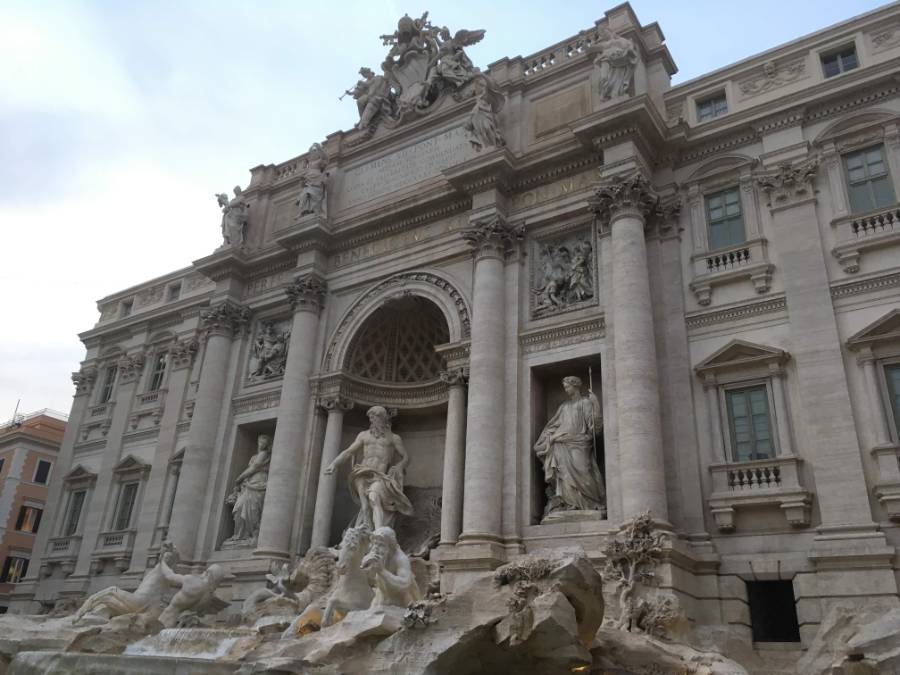
Students in Lipscomb's semester-long Global Learning programs visit other cities during the semester.
This semester Cate Zenzen, a sophomore corporate marketing major at Lipscomb University, is participating in the global learning program in Vienna, Austria. The Vienna group is comprised of students from Lipscomb University, Oklahoma Christian University and Rochester College. This is Part 2 of Zenzen’s blog series to share the group’s experiences this semester. These blog posts are reflections on various events and travel experiences the Vienna students have had over the last few weeks.
Remember for the future
History is beautiful. History is ugly. Every day we see the splendor and wonder of castles, monuments, museums, and landscapes. But on this weekend, we witnessed the perverseness and destruction of humanity clearly defined by the Holocaust.
Our weekend trip to Poland included a visit to the Museum of Wartime Krakow, the former factory of Oskar Schindler who employed Jews and consequently saved their lives, and the concentration camp of Auschwitz. World War II ended nearly 80 years ago, but Europe is still recovering. Many of us thought we were familiar with the horrors of the Holocaust, having read in school testimonies of eyewitnesses and survivors. But at the location itself, where the unimaginable events occurred, it became undeniably real. If the barbed wire wasn’t enough, the piles and piles of possessions stolen from those who were murdered — glasses, shoes, suitcases, clothing, human hair — sealed the image of devastation in our minds.
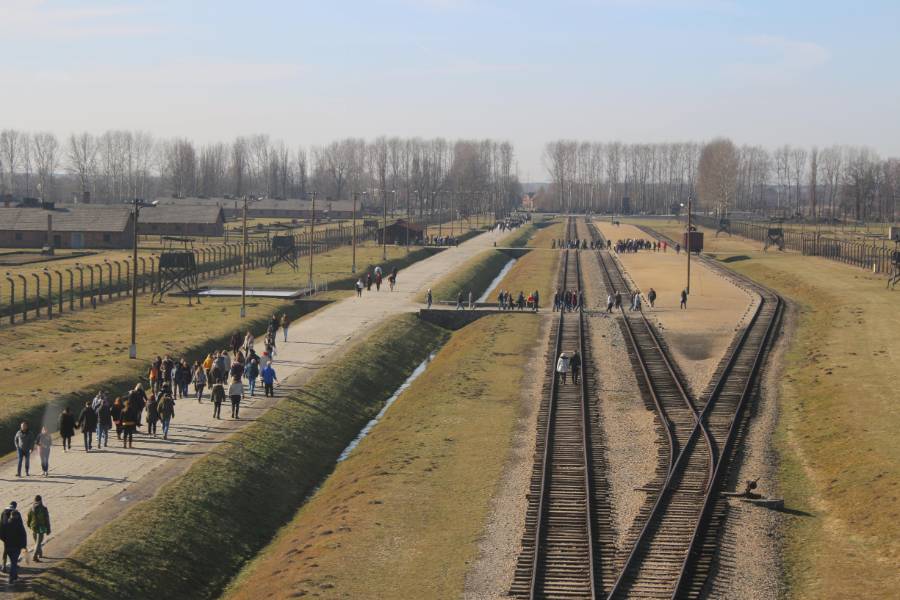
Each semester students in the Vienna global learning program travels to Auschwitz in Krakow, Poland.
It is difficult to view the inhumane conditions in which prisoners lived or to learn about the unspeakable torment the people of Poland endured under the Nazi occupation, but for many Poles this is the story of their families. Our tour guide at Schindler’s Museum told us she considers the building to be her second home, because to her the content is both historical and personal. When Hitler invaded Poland in 1939, her own grandfather joined the Polish Army to defend his home country.
The Germans loved Poland, and many soldiers settled into life at Krakow with no intention of leaving. Of course, this comfort was entirely reliant on the fact that the successful and well-established Poles were taken from their homes to accommodate the Germans. Poland was overcome by Nazi control as part of the expansion of Germany and became the home of many concentration camps.
Originally built as barracks for soldiers, these camps were a convenient place to send the thousands of prisoners who would come either to work or for immediate death. The trains brought them by the thousands; Poles, prisoners of war, professors, intellects, homosexuals, gypsies, Jews — anyone who posed a threat to the “perfect” German nation. Those who were fit to work were condemned to labor for 11 hours a day, those who weren’t went directly to the gas chambers.
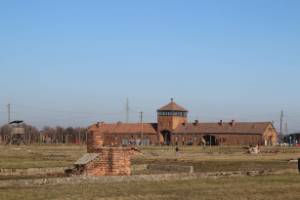
Auschwitz brings to life lessons of the Holocaust.
Today the site of Auschwitz is toured by the thousands. In fact, Vice President of the United States Mike Pence and his wife visited it the day before our group did. At first I thought this popularity was immoral. Why would anyone want to see such a horrific place? But as we entered the camp a quote on the wall by George Santayana stood out to me; “Those who cannot remember the past are condemned to repeat it.” This is exactly why the camp was so well preserved, it is important to fully understand what took place so that it will never happen again.
I felt a shift in the dynamic of our group during this trip. It was not lost on us, as we walked underneath the entrance gate inscribed with the words “Arbeit Macht Frei” (work sets you free), that millions of people walked the same road, but did not leave as we did. Millions of innocent souls traveled the Polish countryside, not in a comfortable coach bus like us, but in cramped, stifling, infested and, excreta-sodden train cars. Millions were denied the basic privileges of life that we hardly acknowledge.
Perhaps now we will think twice before complaining about menial things. Perhaps now little differences in personality won’t matter when it comes to loving each other. Surely now, after seeing the brokenness in the eyes of the prisoners whose photographs are displayed on the walls of Auschwitz, we will recognize the complexity of humanity, the inability to sort someone into a “good” or “evil” category, and the need for kindness in this slowly-healing, post-Holocaust world.
Roma Day One
The beauty of the Lipscomb Global Learning program is that each program is not limited to the designated location. I chose to live in Vienna, but for a week our group traveled south to explore the wonders of Italy. The journey began with an overnight train to Rome. This may sound glamorous but really it means a restless night in a couchette, a six-bunk train compartment with “beds” akin to cheap couches. But any lack of sleep and discomfort was worth it once we reached Rome.
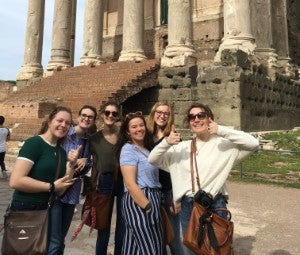
Rome serves as a classroom for a week of travel.
The Mediterranean air and sunshine of the Eternal City -- known for its advanced aqueducts, ancient ruins, and gelato -- made us giddy. Away from the colder Austrian climate, we were all so excited to wear our sunglasses and sandals. The first day was all about exploring and, of course, eating. We strolled past the Colosseum, trekked through ancient ruins, and threw coins in marbled fountains. I know I’m not the only one who had two cones of gelato that day.
Roma Day Two
The next morning we boarded a bus to the city-state Vatican City. Home to the head of the Catholic Church, this sovereign territory contains seven kilometers of historical artifacts ranging from Renaissance paintings, Egyptian mummies and Greek statues. Most notable of the treasures is the handiwork of Michelangelo, the Italian artist who hand-painted the entire ceiling of the Sistine Chapel. These frescoes depict the story of Christianity from Creation to the Last Judgement and provide a stunning backdrop for the private chapel of the Pope.
Every hall of the Vatican had a new treasure to wonder at, but after several hours of disbelief over the talent of these artists I was very grateful for a big bowl of pasta. And more gelato of course.
Roma Day Three
Our final day in Rome started with a tour of the Roman Forum. Uncovered by archeologists, this formerly buried piece of the ancient empire is riddled with marbled columns, statues, and buildings, all connected to age-old myths and legends. Our tour guide shared with us the fairytale story of Romulus and Remus, the orphaned brothers who were raised by a merciful She-wolf and later founded the city of Rome.
The tour offered us a look at the burial place of Julius Caesar, pagan temples-turned Catholic churches, and the former garden of the Farenese family, long diseased. After this tour many of us went to the Colosseum and climbed the steps formerly traversed by thousands of Romans as they prepared to be perversely entertained. While Roman citizens competed in the more popular sport of chariot racing, only slaves, prisoners, and non-Romans (particularly Christians) were forced to fight for their lives in the amphitheater.
For our final evening in Rome, we wandered the city, ate more pasta, and took one last look at famous sites like Trevi Fountain. According to the legend, those who throw a coin into the fountain are destined to return to Rome. Whether true or not, about $3,000 is collected daily from the pool and given to the homeless community. Philanthropy or fable, I certainly enjoyed participating in the famous coin-tossing.
Andiamo a Firenze! Let’s go to Florence!
Firenze Day One
The moment we stepped off the train it was clear, Florence is a completely different city from Rome. Still buzzing with beauty, Firenze (the Italian name) is calmer than Italy’s capital city. With museums full of priceless art, bicyclists-filled streets, Tuscan hills in the distance, and numerous bridges crossing the Arno River, no wonder many students choose this location to be their home for the semester.
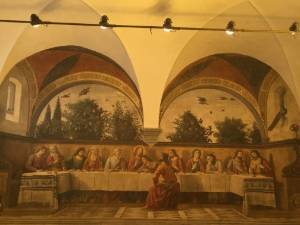
Domenico Ghirlandaio's “Last Supper" was the inspiration for Da Vinci's famous work.
While some members of our groups traveled to Pisa, the rest of us took the day to explore. We ate cannolis and wandered the city until we found the vivid Cathedral of Santa Maria del Fiore, known as the Duomo. The marble cathedral, baptistry, and bell tower are a unique pattern of pink, green, and white and the square surrounding it is just as vibrant with musicians, artists, vendors, and tourists.
As I walked around the city, I noticed that a lot of people were speaking in English. This city seems to be a popular location for students, Lipscomb must not be the only American institution with a study abroad program here. It had been a long time since I felt surrounded by my own native language and it was nice to have that piece of familiarity.
Firenze Day Two
The next morning our group was treated to a walking tour of the city. We saw famous sculptures, churches, and frescoes; including the masterpiece that inspired Da Vinci's “Last Supper.” Our tour guide, an Italian local, had recently returned from vacation and several of her friends greeted her in the streets. It was uplifting and warm to hear a hearty “Ciao” as they kissed each other on the cheeks in traditional Italian greeting. I got a panini for lunch with pear, meat and cheese, and it was possibly the best sandwich I’ve ever had. What made it even better was sitting on the sunny steps and watching the river as a group of dancers freestyled behind me.
Later that day we hiked to Piazzale Michelangelo, a beautiful lookout at the top of a hill. I spent a good amount of time just sitting in the sun and taking in the view. Florence is gorgeous. Often when I travel I want to walk, see, and learn as much as possible, but this frenzy does not work in Italy. Italians relax, they take the time to finish their espresso at the coffee shop, they eat three course meals and allow themselves to talk and digest. Europe is on a different schedule than the United States, and my tired legs greatly appreciated it.
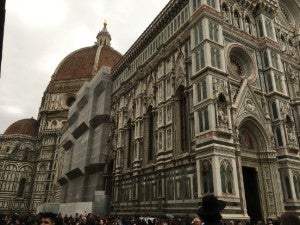
Brunelleschi's Duomo is a favorite site in Florence.
Firenze Day Three
Whoever was responsible for our agenda certainly saved the best for last!
Our final day in Italy began with a visit to the Uffizi Art Gallery, famous for its collection of pieces by Rembrandt, Michelangelo, and Da Vinci. Looking at priceless pieces of art is both fulfilling and draining and I was very excited for lunch afterwards. A group of us went to the Mercato Centrale, a two-story food market packed full of restaurants, vendors, butchers, pasta-makers, and cheesemongers. It is a foodie’s heaven.
Later we moved on to the vendors outside who tried to charm us to buy their leather and assorted souvenirs. Next up was the Galleria dell’Accademia, a small museum with a big centerpiece. The museum begins with religious pieces depicting the Madonna and Child, scenes of the Crucifixion, and sculptures of Greek tragedies, but in the next room stands Michelangelo’s David. Larger than what many of us expected, this 14-foot tall statue was sculpted in 1501 when Michelangelo was only 26 years old. His eyes and relaxed stance portray the young king in what could be the moment before or after his slaying of Goliath. No matter the position of the viewer, David —in all his nude glory—is smooth marble beauty.
To end our incredible time in Italy, we enjoyed a group meal at our hotel. The owner, an Italian woman named Susan, is the fourth generation of her family to run the establishment. To share her culture she treated us with a traditional meal of bread, pasta, salad, meat, potatoes, and panna cotta. Many of us agreed, this was the best meal of the whole trip and a perfect finale to the adventure. Now many of us are off on our next trip, some heading to the United Kingdom and others to Greece. Hopefully we will find some time to rest after such a week!
Learn more about Lipscomb's Global Learning Program.
— Photos by Cate Zenzen